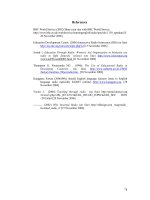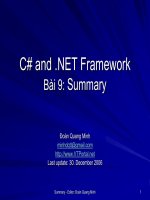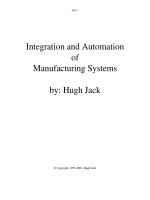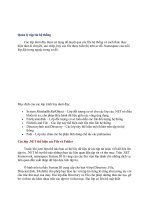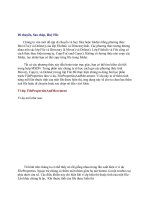Tài liệu INTELLIGENCE AND U.S. FOREIGN POLICY pdf
Bạn đang xem bản rút gọn của tài liệu. Xem và tải ngay bản đầy đủ của tài liệu tại đây (4.61 MB, 432 trang )
A
career of nearly three decades with
the CIA and the National Intelligence
Council showed Paul R. Pillar that in-
telligence reforms, especially measures enacted
since 9/11, can be deeply misguided. They often
miss the sources that underwrite failed poli-
cy and misperceive our ability to read outside
influences. They also misconceive the intelli-
gence-policy relationship and promote changes
that weaken intelligence-gathering operations.
In this book, Pillar confronts the intelligence
myths Americans have come to rely on to ex-
plain national tragedies, including the belief
that intelligence drives major national security
decisions and can be fixed to avoid future fail-
ures. Pillar believes these assumptions waste
critical resources and create harmful policies,
diverting attention away from smarter reform,
and they keep Americans from recognizing the
limits of obtainable knowledge.
Pillar revisits U.S. foreign policy during the
Cold War and highlights the small role intelli-
gence played in those decisions, and he demon-
strates the negligible effect that America’s most
notorious intelligence failures had on U.S. pol-
icy and interests. He then reviews in detail the
events of 9/11 and the 2003 invasion of Iraq, con-
demning the 9/11 Commission and the George
W. Bush administration for their portrayals of
the role of intelligence. Pillar offers an original
approach to better informing U.S. policy, which
involves insulating intelligence management
from politicization and reducing the politically
appointed layer in the executive branch, to com-
bat slanted perceptions of foreign threats. Pillar
concludes with principles for adapting foreign
policy to inevitable uncertainties.
Columbia
Intelligence and U.S. Foreign Policy
PAUL R. PILLAR is visiting professor and
director of studies in the Security Studies Pro-
gram at the Edmund A. Walsh School of Foreign
Service, Georgetown University. He served in
several senior positions with the CIA and the
National Intelligence Council and is a retired
army reserve officer. He is the author of Terror-
ism and U.S. Foreign Policy and Negotiating Peace:
War Termination as a Bargaining Process.
Cover design by Michael Gibson
Praise for Intelligence and U.S. Foreign Policy
“Writing with the authority of a distinguished practitioner and scholar, Paul R. Pillar pres-
ents a blunt and candid assessment of the profound disconnect between intelligence and
American national security policy. His pointed reflections expose the reality of the politi-
cization and misuse of intelligence as well as the importance of the images of the world that
policy makers bring to the table. His book is an invaluable corrective to the assumption that
policy blunders and the inability to predict can be blamed simply on ‘intelligence failure.’”
—Martha Crenshaw, Center for International Security and Cooperation, Stanford University
“Paul R. Pillar has written a brilliant, lucid analysis of the evolution of U.S. national security
intelligence in the decade since the 9/11 attacks. He shows how the intelligence agencies
have been made scapegoats for the failures of our political leaders, how intelligence reform
has become confused with bureaucratic reorganization, and how our foreign policy is driven
by a psychological as well as political incapacity to accept the limitations of our knowledge
about the plans and motivations of actual and potential adversaries. Pillar's book is erudite,
thorough, and authoritative, yet accessible to anyone concerned with the gravest issues of
national and global security.”
—Richard A. Posner, author of Countering Terrorism: Blurred Focus, Halting Steps
“The 9/11 attacks and the Iraq WMD estimate are both encumbered by erroneous legends.
Paul R. Pillar, a senior intelligence analyst deeply involved in both issues, offers crucial cor-
rectives, also applicable to the overly esteemed 9/11 Commission Report. These alone make
this an important book. Pillar goes further, offering a unique history of U.S. intelligence and
the issue of ‘intelligence reform.’ Not all will agree with his observations, but they come
from substantial experience and deep thought and need to be seriously considered.”
—Mark M. Lowenthal, president, The Intelligence and Security Academy, and former Assistant
Director of Central Intelligence for Analysis and Production
“Paul R. Pillar brings to his study of intelligence and foreign policy the skills of an accom-
plished scholar and a wealth of experience as an intelligence officer. A brief endorsement
cannot do justice to the richness and power of his arguments, which are essential reading
for anyone who wants to understand what intelligence can and cannot do; why the appeal of
reforms is often greater than their value; and how we can avoid repeating our past mistakes.”
—Robert Jervis, author of Why Intelligence Fails: Lessons from the Fall of the Shah and the Iraq War
COLUMBIA UNIVERSITY PRESS / NEW YORK
cup.columbia.edu
Printed in the U.S.A.
ISBN: 978-0-231-15792-6
9 780231 157926
INTELLIGENCE AND U.S. FOREIGN POLICY
INTELLIGENCE AND
U.S. FOREIGN POLICY
Iraq, 9/11, and Misguided Reform
Paul R. Pillar
COLUMBIA UNIVERSITY PRESS NEW YORK
Columbia University Press
Publishers Since 1893
New York Chichester, West Sussex
Copyright © 2011 Columbia University Press
All rights reserved
Library of Congress Cataloging-in-Publication Data
Pillar, Paul R., 1947–
Intelligence and U.S. Foreign Policy : Iraq, 9/11, and misguided Reform / Paul R. Pillar.
p. cm.
Includes bibliographical references and index.
ISBN 978-0-231-15792-6 (cloth : alk. paper) — ISBN 978-0-231-52780-4 (electronic)
1. Intelligence service—United States. 2. Iraq War, 2003– 3. September 11 Terrorist At-
tacks, 2001. I. Title.
JK468.I6P55 2010
327.1273—dc22 2010048141
Columbia University Press books are printed on permanent and durable acid-free paper.
This book was printed on paper with recycled content.
Printed in the United States of America
c 10 9 8 7 6 5 4 3 2 1
References to Internet Web sites (URLs) were accurate at the time of writing. Neither
the author nor Columbia University Press is responsible for URLs that may have expired
or changed since the manuscript was prepared.
To Veronica,
who puts her intelligence to good use
LIST OF ABBREVIATIONS IX
PREFACE
XI
CHAPTER ONE Introduction: A Comforting Explanation for Calamity 1
CHAPTER TWO Weapons of Mass Destruction and the Iraq War 13
CHAPTER THREE Alternative Visions of the Iraq War 43
CHAPTER FOUR Congress and the Politics of the Iraq War 69
CHAPTER FIVE Great Decisions and the Irrelevance of Intelligence 96
CHAPTER SIX Politicization 121
CHAPTER SEVEN Scapegoats and Spectator Sport 175
CHAPTER EIGHT The Never-Ending Issue 202
CHAPTER NINE Catharsis and 9/11 233
CONTENTS
viii CONTENTS
CHAPTER TEN Responses to Catharsis 281
CHAPTER ELEVEN The Illusion of Reform 293
CHAPTER TWELVE Real Reform 311
CHAPTER THIRTEEN Adapting Policy to Uncertainty 331
NOTES 357
INDEX 401
9/11 September 11, 2001
9/11 Commission National Commission on Terrorist Attacks Upon the
United States
ASAT antisatellite
BJP Bharatiya Janata Party
CBRN chemical, biological, radiological, or nuclear
CIA U.S. Central Intelligence Agency
CTC Counterterrorist Center
DCI director of central intelligence
DNI director of national intelligence
DRV Democratic Republic of Vietnam
ExComm Executive Committee
FAA Federal Aviation Administration
FBI Federal Bureau of Investigation
IAEA International Atomic Energy Agency
ICA intelligence community assessment
INR Bureau of Intelligence and Research
MACV U.S. Military Assistance Command Vietnam
NASA National Aeronautics and Space Administration
ABBREVIATIONS
x LIST OF ABBREVIATIONS
NCTC National Counterterrorism Center
NIC National Intelligence Council
NIE national intelligence estimate
NSA National Security Agency
NSC National Security Council
ODNI Of ce of the Director of National Intelligence
PCTEG Policy Counter Terrorism Evaluation Group
PNAC Project for the New American Century
SALT strategic arms limitation talks
SLBM submarine-launched ballistic missile
UNMOVIC United Nations Monitoring, Veri cation, and
Inspection Commission
VFW Veterans of Foreign Wars
WMD weapons of mass destruction
March 29, 1973, found me aboard a C-141 transport plane, along with fty
other U.S. servicemen, returning to the United States after duty in Viet-
nam. The ight was the last in the withdrawal of U.S. military forces under
the terms of the peace agreement that the United States and North Viet-
nam had reached in Paris two months earlier (not to be confused with the
much more hazardous and chaotic exodus of the few remaining Americans
when the agreement broke down and Communist forces overran South
Vietnam in April 1975). I was on that nal ight because my assignment
since arriving in Vietnam the previous April was at a replacement depot
called Camp Alpha at Tan Son Nhut Air Base on the outskirts of Saigon,
which during the last year of the war was the processing point for almost
all U.S. military personnel entering or leaving Vietnam. Once the peace
agreement was reached, those of us who did the processing at Camp Alpha
had to send the other remaining troops on their way before we ourselves
could leave.
What had once been an American force of more than half a million was
down to about twenty-four thousand when the Paris Accord was signed.
The withdrawal of that residual force (except for a few embassy guards and
members of a joint military commission to monitor implementation of the
PREFACE
xii PREFACE
agreement) was supposed to be synchronized with the repatriation of
American prisoners of war from North Vietnam. The withdrawal pro-
ceeded in ts and starts because of disagreements over implementation
ofthe agreement. Sometimes we would load a plane with soldiers who hap-
pily thought they were within minutes of leaving Vietnam, only to be or-
dered to unload it because an aircraft with prisoners of war had not taken
off on schedule from Hanoi. The biggest hiccup occurred with two weeks to
go in the withdrawal, when our ight operations were suspended altogether.
Once the underlying problem was resolved, we had three days to ship out
the last ve thousand troops. And we had to do this while signing over re-
maining property to the embassy, making nal payments to our Vietnamese
employees, packing our own bags, and trying to keep the compound we
were about to vacate from being looted. I got almost no sleep during those
three days and as a result slept most of the way across the Paci c.
We at Camp Alpha had it easy, however, compared to those we
processed—and many more before them—who had experienced directly
the stresses and horrors of combat. Other than two Viet Cong rocket bar-
rages against the airbase, I saw not enemy re but instead some of the other
ways the Vietnam War in icted damage on the army as well as on Ameri-
can society. U.S. troops’ burgeoning use of narcotics had become a particu-
lar problem by that late stage of the con ict. The most important piece of
processing we did with soldiers exiting Vietnam was a urinalysis to identify
the disturbingly large number of heroin users.
After landing in California, we on that last ight exited the plane onto
a red carpet and along a receiving line that included several generals. The
arrival festivities were partly a celebration of the end of an eight-year-long
national nightmare. Later that night I joined my battalion commander and
one of our noncommissioned of cers to participate in another ceremony at
the since-closed army base in Oakland to deactivate our unit, the Ninetieth
Replacement Battalion. The unit had rst been created to serve the Amer-
ican Expeditionary Force in World War I and had later seen service in
World War II. A reporter at the ceremony asked for my thoughts. I expressed
hope that the battalion was furling its colors for the last time and would
never need to be activated again.
These events were to have connections with subsequent professional
endeavors, including ones I never could have anticipated at the time. Hav-
ing participated at the low end of an effort to extract the United States
from a war, I became interested in how things work at the high end. This
PREFACE xiii
interest led to a doctoral dissertation, which I later turned into a book, on
the principles and dynamics of peace negotiations and the role that mili-
tary force plays as an accompaniment to them.
1
Later in my career I worked on counterterrorism, and that subject would
have a more personal connection with my experience in Vietnam. One of
my most effective and valued colleagues at Camp Alpha was an experi-
enced master sergeant named Max Beilke. Max was a paragon of calm and
good judgment, with a low-key and effective way of bringing order out of
confusion. When the last hectic days of the troop withdrawal ended, and it
was time for the remaining few of us to get on our aircraft, a North Viet-
namese colonel was waiting on the tarmac to mark the occasion with a
gift—a rattan-backed painting of a pagoda—to whoever was the nal sol-
dier to leave. It was decided that Max, as one of the most senior enlisted
men to board our ight, should receive the honor. And so he became for-
mally and of cially the last American combat soldier to depart Vietnam.
Max retired from the army shortly afterward and as a civilian worked in a
variety of capacities on issues of concern to military veterans. I did not stay
in regular contact with him—we got together for lunch a few years later—
but I knew he eventually went to work with the personnel staff at the De-
partment of the Army. Thus, I thought of him when hearing news that of-
ces used by this staff were in the part of the Pentagon hit on September 11,
2001. Max was in fact there that morning, making him one of two people
with whom I had ever worked who perished in the 9/11 attack. The other was
John O’Neill, the former FBI counterterrorist chief who, having started a
second career as director of security at the World Trade Center, was in one of
the towers when it collapsed.
A different sort of connection to the end of the Vietnam War came in
my last few years of government service. I was the national intelligence
of cer for the Near East and South Asia during a period (2000–2005) in
which the war in Iraq was sold, launched, and became a quagmire. Thus,
two tragically ill-conceived military expeditions were bookends to my
thirty years of public service (two in the army and, after an interval as a
student, twenty-eight in the intelligence community). The perches from
which I observed the end of one misguided war and the beginning of an-
other were quite different—a junior army of cer in the eld in one, a senior
intelligence of cer in Washington in the other—although I hardly had
any more in uence on events in one job than in the other. The signi -
cance of these two wars in my life has prodded my thinking about why the
xiv PREFACE
United States gets into such costly misadventures. This book addresses
what is commonly, even if mistakenly, perceived to contain much of the
answer to that question.
My career in the U.S. intelligence community provided a vantage point
for observing directly many of the patterns discussed in this book. That
vantage point also made clear that an extraordinarily large proportion of
public commentary about intelligence is ill informed. This pattern in part
re ects the special qualities of intelligence, which combines an unavoid-
ably large amount of secrecy and opacity with a fascination and intrigue
that have made it a favorite subject of writers of ction and non ction alike
as well as of writing that unfortunately blurs the two.
My experiences in intelligence brought pride and satisfaction. I entered
the profession for reasons similar to the corny but commendable ones I
hear from my students who are interested in entering it—wanting to serve
the public interest and hoping to have a favorable impact on public policy
and address problems that present as much intellectual challenge as any
inside government. As parts of this book make apparent, any young of cer
who enters the profession with expectations about saving the world through
brilliant intelligence will quickly have such expectations de ated. But I
had my share of high points on a wonderfully diverse set of issues. For
example, I accompanied Director of Central Intelligence William Webster
as his executive assistant when he became the rst director to visit eastern
European countries shortly after Communist rule crumbled. Several years
later I had the satisfaction of being the lead (and originally the sole) intel-
ligence of cer in the initial rounds of secret talks with Libya that led Colo-
nel Muammar Qadha ’s regime to give up its unconventional weapons pro-
grams and become an ally rather than an enemy in efforts against international
terrorism.
I am not primarily an intelligence of cer by sentiment or temperament,
however. I was trained as a political scientist, the profession I currently
practice as a university professor. During my career in government service,
I often felt like an academic trapped inside a bureaucrat’s body. This book
is written less from the perspective of a former intelligence of cer than
from the perspective of a concerned citizen and scholar of foreign policy
who happens to have additional insights gained from previous experience
in intelligence.
I have known and worked with many of the of cials and former of cials
who populate this book, in addition to the few about whom I explicitly
PREFACE xv
mention such a personal connection. Some of my former colleagues may
dislike some observations that appear to question their usefulness and even
their integrity. That is not my intent. Others may interpret some of my
observations as an attempt to exculpate the U.S. intelligence community,
to obscure its shortcomings, and to shift to others the blame it has incurred
for past failures. That also is not my intent. This book will have achieved
its main purpose if it helps to get Americans away from blame games alto-
gether and leads them to ponder how the making of their country’s foreign
policy is really—not just theoretically or ideally—informed and guided and
what this understanding implies for making that policy better guided.
I owe thanks primarily to the many colleagues inside and outside the intel-
ligence community with whom I worked while a public servant. As a citi-
zen, I salute them for contributions to the national interest that are almost
entirely unknown and too often unappreciated. More personally, I thank
them—especially those who at one time or another were my subordinates—
for helping me do my own jobs and for being so congenial in the process.
Any attempt to name speci c individuals would surely entail many inad-
vertent omissions and might also be a complication for some still in
government.
Since I retired from public service, Georgetown University and its Cen-
ter for Peace and Security Studies have furnished me with a stimulating
professional home. I have bene ted in intellectual enrichment and other
ways from interaction with the students, staff, and my fellow faculty mem-
bers at the center and its associated Security Studies Program. I am grateful
to Daniel Byman, a remarkably energetic scholar and academic leader who,
as program director, was most responsible for bringing me to Georgetown.
I also thank Robert Gallucci, then dean of the Walsh School of Foreign
Service, for acceding to Dan’s idea of taking me on board. I have continued
to bene t from the leadership of the current program director, Bruce Hoff-
man, and the current dean, Carol Lancaster.
I have honed the ideas in this book in informal discussions about intel-
ligence with sundry friends and associates from either my rst or my second
career. Several are regulars in the intelligence salon led by Jennifer Sims of
Georgetown. The salon critiqued a draft of one chapter of the book. Rich-
ard Betts, who has long been one of the most insightful scholars of intelli-
gence, read the entire manuscript and offered helpful suggestions. I have
pro ted from exchanges of ideas over several years with Robert Jervis,
xvi PREFACE
another perceptive academic observer of intelligence and contributor to the
literature on it. Eva Brown, Alissa Gordon, Stephen Ryan, and Samantha
Vinograd provided research assistance.
I have presented some ideas in this book in different form in articles in The
National Interest , Foreign Affairs , Intelligence and National Security , and the
SAIS Review . I thank the editors of those journals for their invitations to de-
velop my thinking on the subject and to present some of the results in their
publications. I also thank Anne Routon and Leslie Kriesel, the editors at Co-
lumbia University Press who have shepherded this book, and Annie Barva,
who copyedited the manuscript.
As a condition of my former government employment, the CIA has re-
viewed this book to ensure that it contains no classi ed information. That
review has not affected the substance of the book. I am solely responsible for
its contents. Nothing in this book re ects any position of or authentication
or endorsement by the CIA or any other part of the U.S. government.
My family has exhibited exemplary forbearance in the face of my preoc-
cupation with this project. My wife, Cynthia, has provided support in ways
too numerous to list while stoically observing that retirement from the
government did not seem to reduce my working hours. My daughter, Ve-
ronica, and son, Lucas, have exhibited patience in other ways, for which
Ialso am grateful.
Washington, D.C.
January 2011
INTELLIGENCE AND U.S. FOREIGN POLICY
Why does the foreign and security policy of the United States so often
seem to be not just unsuccessful but misguided, being based on incomplete
or otherwise mistaken images of the outside world? Some of the most memo-
rable episodes in America’s relationship with the world have included de-
bilitating wars—Vietnam and Iraq being the leading examples—in which
the decisions to wage war appear to have been based on incorrect percep-
tions of those countries. They have included placing bets on ill-fated re-
gimes, such as that of the shah of Iran. They have included falling victim
to surprise attack, most notably at Pearl Harbor in 1941 and in New York
and Washington, D.C., sixty years later. How can the United States—pow-
erful and resourceful as it is, with its leaders surely able to call on the best
possible sources of insight and information—be so badly and sometimes
tragically mistaken about events beyond its borders?
The impression of chronic error is partly a matter of selective retrospec-
tion. One can easily nd offsetting successes. Along with the debilitating
and inconclusive wars have been victorious ones, including the two world
wars of the twentieth century, the Cold War, and the war to expel Iraq from
Kuwait. Losing bets on speci c countries or regimes are offset by winning
ones such as the Marshall Plan, whose payoff came in the form of stable
CHAPTER ONE
INTRODUCTION
A Comforting Explanation for Calamity
2 INTRODUCTION: A COMFORTING EXPLANATION FOR CALAMITY
and strong European allies. And although the converse of a surprise at-
tack is a nonevent and thus inherently less visible, favorable nonevents
such as attacks that did not happen have also been a part of the history of
U.S. relations with the rest of the world. A fair appraisal of the more than
two centuries of that history suggests that, on balance, well-conceived and
well-guided policies have added to the good fortune of geography and re-
sources to help put the United States in the enviable position it reached
by the opening decade of the twenty- rst century. One of the most perspi-
cacious students of American foreign relations, Walter Russell Mead, ob-
serves that overall “the United States has had a remarkably successful
history in international relations.”
1
Many of the successes have depended
not only on sound judgment and skillful execution but also on accurate
underlying images of the foreign reality with which the policymakers have
dealt.
Regardless of whether the bottom line of the U.S. foreign-policy balance
sheet is colored black or red, how can it be improved in the future? Bad
foreign policy has numerous possible ingredients, but among the more im-
portant presumably are the images that policymakers hold of the foreign
situations to which their policies are a response. Those images include the
policymakers’ perception of current reality, their understanding of the forces
and dynamics at play, and usually their sense of where the events in ques-
tion are heading. The whole package is a construct that, whatever its ori-
gins, is tied more closely to the decision maker’s mind than to the outside
world that the decision maker believes it represents. It is accordingly more
appropriate to call this construct an image rather than knowledge.
2
In one sense, there has been plenty of attention to this ingredient in
discussions of U.S. policy. Anguish in recent years over the twin traumas
of the terrorist attack of September 11, 2001—commonly known as 9/11—
and the Iraq War has been expressed chie y in terms of mistaken images:
of threats that supposedly were underrated in one instance and overrated
in the other. But most of the anguish has an extremely narrow focus that
overlooks the most important inputs to the images policymakers hold and
how images actually shape policy, if they shape it at all. That narrow focus
has been on what are termed “intelligence failures” and on the need to x
or reform intelligence. Narrowing the focus even more, intelligence gets
equated with the output of certain elements of the U.S. government that
have the word intelligence in their names or that have the gathering of in-
telligence as their primary mission.
INTRODUCTION: A COMFORTING EXPLANATION FOR CALAMITY 3
This very constricted form of attention to the causes of misguided pol-
icy stems in part from how the making of foreign and security policy is
supposed to work. The textbook model of the policy process involves de-
cision makers dispassionately re ecting on the information and analysis
available to them—the principal source being an equally dispassionate
intelligence service—and then selecting a course of action based on that
re ection.
The narrow focus of attention stems at least as much from emotion and
public psychology as it does from textbooks. We like to attribute woebegone
wars and shocking surprise attacks to the shortcomings of intelligence ser-
vices because this explanation is easily understandable and because it of-
fers the comforting prospect that by xing such shortcomings, we can pre-
vent comparable calamities from occurring. It would be far less comforting
to conclude that mistaken images underlying failed policies had sources less
susceptible to repair, that relevant misperceptions resided more in our
own heads or the heads of political leaders we elected than in unelected
bureaucracies, or that some of the most important things we did not know
were unknowable to anyone on our side, even if we had the most exemplary
intelligence service.
These tendencies are especially marked for Americans. It is natural to
assume that the superior capabilities that have enabled the United States
to do so well in so many other endeavors apply also to the forming of ac-
curate images of the outside world. If the United States could win world
wars, put a man on the moon, and do all the other marvelous and dif -
cult things it has accomplished, then according to reason it should be
able to perform just as well the task of determining what is going on in
other countries.
The tendency toward exceptionalism—the idea that the United
States is not only good at many things, but also better than anyone else—
contributes to this pattern. This tendency obscures inconsistency between
how other countries are believed to form their images of the outside world
and how America is believed to form its. Many Americans see nothing
contradictory in believing that foreigners are prisoners of parochial biases,
but that they themselves are not.
These perspectives color Americans’ attitudes toward their own institu-
tions, including governmental institutions. The opening words of the U.S.
Constitution set the tone in referring to the formation of “a more perfect
union.” Perfection being an absolute, “more perfect” does not make semantic
4 INTRODUCTION: A COMFORTING EXPLANATION FOR CALAMITY
sense. But the constitutional preamble captures well an American outlook
that combines unbounded faith in what institutions ought to be able to do
along with an engineer’s problem-solving perspective that when dif culties
arise, the machinery of government needs to be and can be xed. The
American belief in the “inde nite perfectibility of man” that Alexis de Toc-
queville observed in the nineteenth century extends as well to a belief in
the inde nite perfectibility of American institutions.
3
A consequence of this outlook is a strong belief that if the relevant insti-
tutions are working well, the United States ought to hold accurate images
of the outside world. A more speci c consequence is the persistent Ameri-
can tendency to attribute failures of U.S. foreign and security policy to the
policymakers’ having been misguided, to attribute the misguidance to
failures of intelligence institutions, and to believe that the proper response
is to x intelligence.
A major refrain in discourse about making U.S. foreign and security
policy better is thus intelligence failure and intelligence “reform.” (I often
put the term reform in quotation marks because as generally used it refers to
any change to intelligence institutions not initiated by the institutions
themselves rather than to improvement per the dictionary de nition of the
term.) The refrain has been heard for decades in a huge ow of of cial pro-
nouncements and unof cial commentary. The ow is unending. It implicitly
promises a reformist nirvana in which, with the right xes, Americans nally
can stop fretting about the ineffectiveness of their intelligence services. But
the nirvana is never reached.
The xation on intelligence failure and reform sustains several mis-
conceptions that this book aims to dispel. Among the realities that are
contrary to broadly held belief and that later chapters demonstrate are:
• Despite intense attention to an infamous intelligence estimate in
2002 on Iraqi unconventional weapons, most prewar intelligence analysis
on Iraq was good, especially regarding the prospective consequences of the
war. The policy implication of the intelligence community’s work on Iraq was
to avoid the war, not to launch it.
• Despite near-universal acceptance of the 2004 report by the National
Commission on Terrorist Attacks Upon the United States (9/11 Commis-
sion) as thorough and careful, the commission misrepresented much of the
intelligence community’s pre-9/11 strategic work on terrorism and never
mentioned large portions of it. This misrepresentation and elision distorted a
INTRODUCTION: A COMFORTING EXPLANATION FOR CALAMITY 5
record in which the intelligence community successfully identi ed and de-
scribed the threat from al-Qaida and imparted that threat to policymakers.
• Notwithstanding some instances (such as with terrorism) of intelli-
gence enlightening policy, the overall in uence—for good or for ill—of
intelligence on major decisions and departures in U.S. foreign policy has
been negligible. Most notorious intelligence failures have similarly had
almost no effect on U.S. policy or U.S. interests.
• Policy has shaped intelligence more than vice versa. This relationship
has entailed signi cant corruption of intelligence through politicization,
but of cial inquiries have refused to recognize this in uence.
• The intelligence community—contrary to its common image as a
stodgy bureaucracy that must be pushed into reform—has exhibited nearly
continuous internally driven change and adaptation. Almost every subject
raised by would-be reformers outside the community has already been a
focus of concentrated attention by the community itself.
• The most important sources of images guiding policy and thus the
leading opportunities for making those images more accurate have noth-
ing to do with intelligence and instead lie within the political strata of
government.
Whatever solace the common beliefs about intelligence have provided
to Americans looking for reassuring explanations for past setbacks, they
have done almost nothing to make American policy better informed and
more intelligently formulated. Hence, the main message of this book is:
Efforts to make U.S. foreign and security policy better guided, based on the
notion of intelligence reform, are themselves misguided. They miss the sources
of mistaken images underlying failed policies, misconceive the intelligence–
policy relationship as the reverse of how it often works, produce “reform” that
does not improve intelligence and in some respects makes it worse, misperceive
the limits to understanding the outside world, and encourage foreign policies that
are unsound because of the failure to recognize those limits.
The dominant approach, focusing on intelligence failure and reform, to
making U.S. policy better informed is misguided in part because actual
formulation of policy is far different from the textbook model. Even though
intelligence makes important contributions to national security every week
on matters ranging from ferreting out terrorist cells to monitoring enhance-
ments to foreign military forces, it has not had anything close to the guid-
ing role in policy that it does in the model. One reason why it hasn’t is that
6 INTRODUCTION: A COMFORTING EXPLANATION FOR CALAMITY
images of the world abroad, from whatever source, are only one input to
foreign-policy decisions and not necessarily the most in uential. Other
factors, from presidential neuroses to domestic political interests, are often
more powerful. Another reason is that to the extent that images of the world
abroad do shape policy, intelligence is only one possible source. It is much
less in uential than sources that are closer to the policymakers’ minds and
hearts. The latter sources include individual leaders’ personal experiences
of other leaders (such as Harry Truman’s likening of Stalin to Truman’s
former patron, Kansas City political boss Tom Pendergast)
4
and entire gen-
erations’ historical experiences (for example, Hitler’s serving as a repeat-
edly invoked analogy for other foreign dictators).
Those more personal and formative sources of images have a much greater
chance than any report from an intelligence service to break through
and to mold worldviews—which in the political realm are usually called
“ideologies”—that shape our perceptions of the world around us.
5
This
shaping is how our brains avoid being paralyzed by the torrent of informa-
tion our senses continually gather and the inconsistencies within it. We
discard or distort new information to t into a preexisting worldview far
more than any new information changes the worldview.
6
This is at least as
true of political leaders, who lack time for contemplation and reeducation,
as of the rest of us. Doris Kearns Goodwin has noted this pattern, which
she saw rsthand in Lyndon Johnson but can be applied to political leaders
generally: “Worldviews, once formed, are dif cult to change, especially for
politicians. Always reacting and responding, their life largely one of move-
ment among and contact with others, politicians are nearly always bound
to the concepts and images formed in their minds before taking of ce, or
those evolved from well-established and therefore safely followed sources of
knowledge and guidance. If their ideas about the world sometimes sound
like assumptions from a forgotten age, it is, in part, the price they pay for a
life of continual motion.”
7
In addition to the more personal sources of images of the outside world
and to the personal and political considerations that in uence policy re-
gardless of the images, policymakers share with their countrymen whatever
peculiar ways of looking at the world ow from their nation’s history, physi-
cal circumstances, and culture. The very distinctive history and circum-
stances of the United States has made for some distinctively American
ways of looking at problems in the rest of the world. It therefore should be
no surprise that inputs from an intelligence service have had so little in u-
